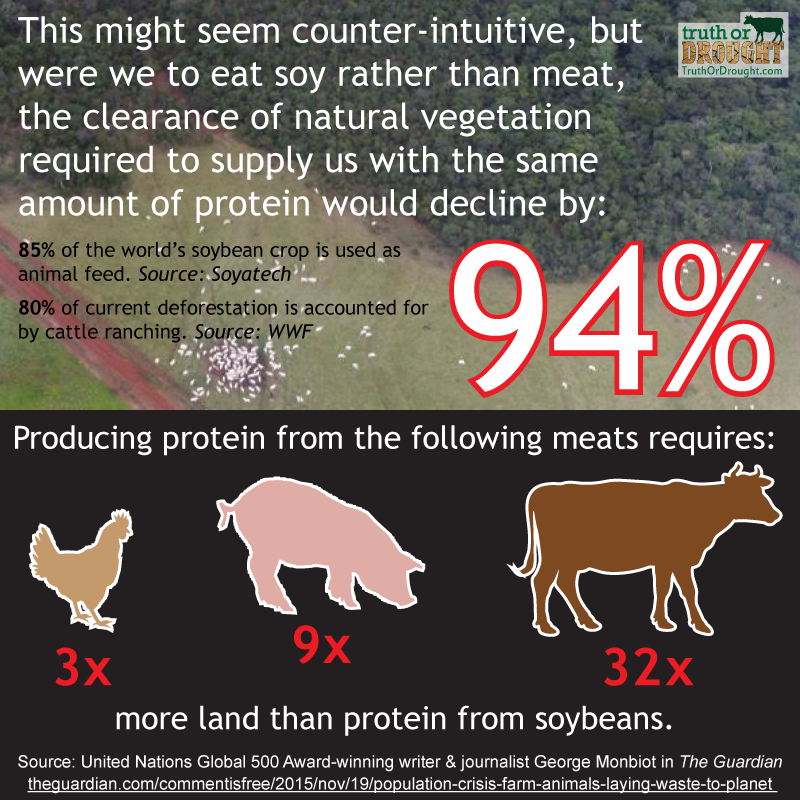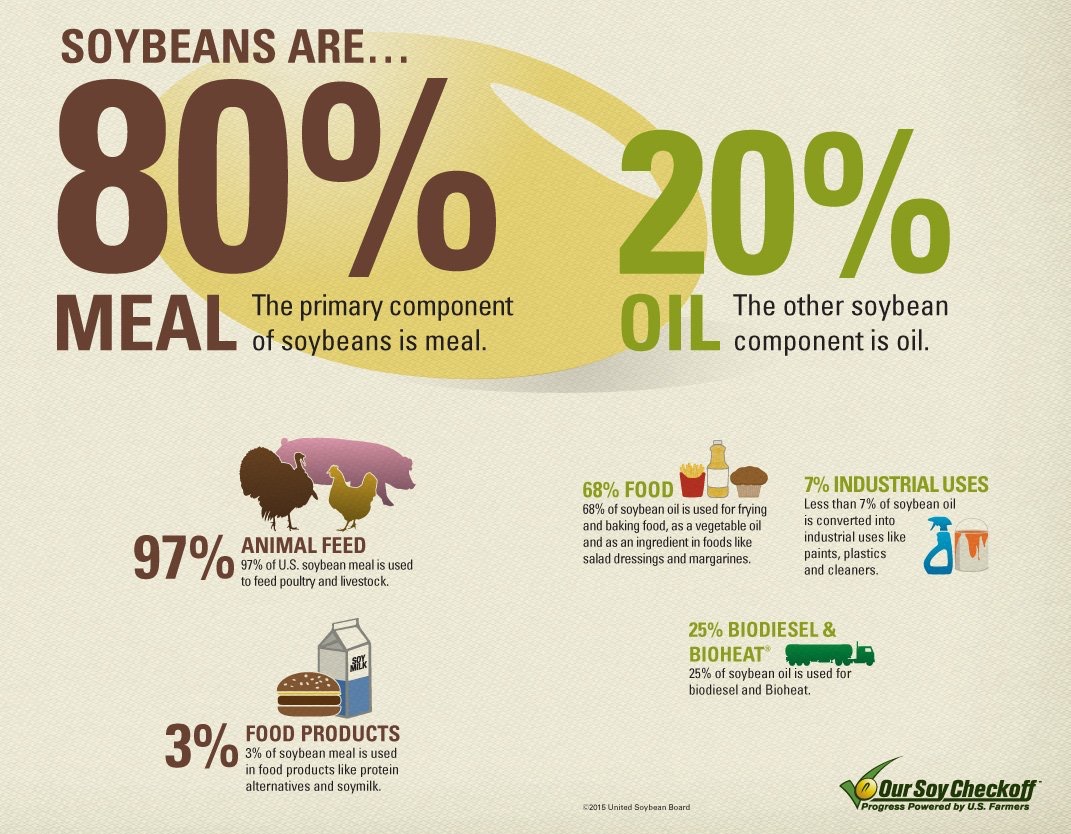Where Soy Beans Originaly Made for Cow Feed
Source:
Widely made assumption.
Tactic:
-
Blaming vegans for the damage caused by non-veganism
-
Conflating efficient primary consumption (of soy-based foods) with wasteful secondary consumption (of soy-fed animals)
Truth:
There's nothing inherently environmentally damaging about farming any type of bean, including soybeans; they're actually a highly efficient protein source. The damage is caused by growing said bean to fatten up tens of billions of farmed animals, because then an unreasonable and unsustainable amount of beans must be grown. The fact is that 85% of the world's soybean crop is used as animal feed (Oilseed & Grain News). Soy-fed livestock foods have a much larger environmental footprint than livestock-free soy foods, like all animals-source vs. plant-based foods in general. The way to prevent soy over-farming is by eating it directly in the form of vegan soy foods rather than cycling it through animals before consumption.
"Increasing meat consumption is the main driver behind soy's continuing expansion. Around three-quarters of soy worldwide is used for animal feed, especially for poultry and pigs."

Think of it it this way:
A quarter of all Americans regularly buy hummus – far more than those who buy tofu. Yet garbanzo beans are not destroying the planet, because they're not being used to fatten up tens of billions of farmed animals. If they were, they too would be destroying the planet, and it would have nothing to do with hummus, or vegans, or the beans themselves.
Veganism is not responsible for animal agriculture's egregious misuse and squandering of soybeans. Primary consumption of soybeans in the form of soy foods—which, unlike soy-based feed, are often organic and non-GMO if that's a concern—respects our planet's ecological limits. Cycling crops like soy through animals to consume their flesh and bodily fluids does not. (Nor does the alternative, in the case of ruminant animals, of devoting massive amounts of land to their grazing.)
Says WWF, "Limiting consumption of animal-based food products, particularly meat, is one thing people can do to help end this devastating trend [of soybean over-farming]." Note that reducing consumption of animal meat/products, not soy foods, is the effective action people can take.

The same dynamics apply to other foods used as feed, such as corn and grain. Corn is the largest crop grown by American farmers, and it's largely responsible for the ongoing depletion of the Midwest's massive Ogallala Aquifer – but it's not because of vegans or anyone else secretly sitting around eating corn on the cob all day, it's because it's the most widely-used feed crop in the US. But since corn and grain aren't particularly associated with vegans like soy is, people seem to be less inclined to implicate their overproduction in the ongoing destruction of our environment.
The fact that people are willing to blame vegans for the damage specifically caused by non-vegans' secondary consumption of soybeans and other animal feed shows how little most people have actually thought about the logistics of farmed animal production. Those who do understand yet are still spreading this myth are being intentionally obtuse knowing that most people won't have the above context.
"The early popularity of soybeans was due to their nitrogen-fixing properties and conservation uses."
Bean, Beans, Good for the Earth
Soybeans are actually incredibly land-efficient. USDA states, "The early popularity of soybeans was due to their nitrogen-fixing properties and conservation uses." The UN FAO calls beans and other legumes "climate smart" and "key to global food security," meaning that they are not only highly nutritious but also nitrogen-fixing, carbon-sequestering, adaptive, and drought-resilient. This, in combination with their water efficiency, means, per Oxfam, that beans and legumes are also not overly demanding of global water resources. Soybeans in particular produce at least twice as much protein per acre than any other major vegetable or grain crop on Earth. The inherent sustainability of soy, however (like any crop), is contingent upon it being directly consumed by humans, not by farmed animals and then humans.
"80% of Amazon soy is destined for animal feed; smaller percentages are used for oil or eaten directly."
Soy Agriculture in the Amazon
Although many people assume the soybeans grown in the Amazon are for popular vegan foods like tofu and soy milk, the reality is that, per Yale School of Forestry and Environmental Issues, "80% of Amazon soy is destined for animal feed; smaller percentages are used for oil or eaten directly."
Eating soy directly rather than cycled through animals first would reduce the clearance of natural vegetation required to supply us with the same amount of protein by a whopping 94% (The Guardian). Humans logically wouldn't need to tear down the Amazon to grow soybeans that were merely being used for vegan food, because in bypassing animals we could grow far less of these crops using far less land.
See our resource on land use and deforestation for more research that shows, between clearing for pastures and feed crops like soy, beef production is the top driver of Amazon deforestation.
"This might seem counter-intuitive, but were we to eat soya rather than meat, the clearance of natural vegetation required to supply us with the same amount of protein would decline by 94%. Producing protein from chickens requires three times as much land as protein from soybeans. Pork needs nine times, beef 32 times."
On Blaming Soy Oil Demand for Soybean Over-farming
An increasingly common narrative claims that farmed animals are just helpfully "upcycling" the soy meal leftovers from soy oil production. Excessive soy farming, however, cannot coherently be blamed on human demand for soy oil. Soy oil is found in many processed foods because it's cheap and readily available, which would not be the case without the "livestock" industry's heavy use of soy meal.
Soybean farming generates large amounts of soy oil as a byproduct of processing soy meal to meet the demand for animal feed—not the other way around. Soy beans actually contain the least oil of all major oilseeds, and about four times more meal than oil. According to the United Soybean Board, "meeting animal [farmers'] needs drives meal demand," and soy "meal is the engine that drives profitability," not soy oil.

"Soybean meal moves through the market as a direct reflection of livestock needs."
United Soybean Board
Image at left: FCRN (click for article)
"''Soybeans produce at least two times as much usable protein per acre than any other major vegetable or grain crop, except for hemp... They produce 5 to 10 times more protein per acre than land set aside for grazing animals to make milk, and up to 15 times more protein per acre than land set aside for meat production.''"
Further reading:
A note about anti-soy health claims
Because soy foods threaten unrivaled meat industry dominance, unsubstantiated health claims against soy foods are made just as often as environmental ones. This campaign generally doesn't address health claims, but this one is so pervasive that we must.
To understand the ironic, almost paradoxical motivation for soy-bashing, consider the following:
"Because soybeans are high in protein," explains the North Carolina Soybean Producers Association, "they are a major ingredient in livestock feed."
Wait a minute – aren't we were supposed to eat the livestock animals because they're high in protein?
"Soy foods are cholesterol-free, excellent sources of high quality protein, and they offer a healthy mix of polyunsaturated fat," brags the Wisconsin Soybean Association, with Healthline noting that soybeans are "fairly high in fiber."
But hang on, doesn't meat have cholesterol and saturated fat, and NO fiber? So we take the beans and add bad things to them that weren't there before and remove the good stuff?
"Animal agriculture is a soybean farmer's #1 customer."
Gotcha. Guess we won't ask questions, then.
Due to scientific laws of trophic levels, primary soy consumption of plant-based foods like tofu requires far fewer soybeans to be grown and sold than does secondary soy consumption of meat, milk, and eggs from soy-fed animals. Soybeans are highly subsidized, masking the high material cost of inefficiently cycling them through countless animals rather than just eating them directly. Even though most of the world's soybeans are consumed indirectly by humans through soy-fed animals, vegan foods made from soy (a far more efficient use of soybeans) are often framed as being inferior, inadequate or unsafe.
Starting to see the bizarre paradox here?
Unsurprisingly, this anti-soy fear-mongering originated with meat industry advocacy organizations like the Weston Price Foundation, as explained in the article A Vegan Doctor Addresses Soy Myths and Misinformation, and it spread like wildfire in a society looking for anti-vegan/pro-meat confirmation bias. However, the largest organization of food and nutrition professionals in the world (the Academy of Nutrition and Dietetics) supports soy as a healthy food staple rather than a "danger," per Clearing Up Confusion Over Soy and RD Resources of Consumers: Safety of Soy.
Much of the hysteria is based on something called phytoestrogens, often conflated with actual estrogen. Per Harvard, 60-80% of the actual estrogen in human diets comes from consuming the lacteal secretions of pregnant or recently pregnant, massive one-ton cows (in the form of "dairy"). Phytoestrogens, on the other hand, are naturally occurring plant compounds – actually more abundant in flaxseeds than soy – that are weak or actually block estrogen's effects.
Also, many of the soy studies were on animals given massive amounts of soy that no one would ever realistically consume. Like any other food, it should be eaten along with a variety of other foods. But unless you are allergic or believe you have an intolerance, it does not have to avoided.
It's clear that little critical thought has gone into the anti-soy health myths that have unfortunately scared many people away from soy-based vegan foods, but not soy-based animal foods – which was the exact intention of the smear campaign.
You're smarter than that. Rather than being some dangerous pox on the our planet, soybeans are a highly nutritious vegan source of all eight amino acids (making it a "complete protein") and a very important food source historically and globally. Don't be afraid of a bean.

The Facts
Gain a clear understanding of the various ways animal agriculture harms our planet.
Learn More →

The Myths
Challenge the narratives that downplay the negative impacts of animal production & vilify vegan diets.
Learn More →
Source: https://www.truthordrought.com/soybean-myths
Post a Comment for "Where Soy Beans Originaly Made for Cow Feed"